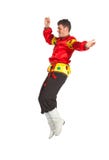
What is the traditional clothing of Albania? In short, the men’s traditional attire of Bosnia and Herzegovina consists of a white shirt , baggy pants , a small waistcoat , a wide belt , a headdress (usually , a fez ), optional outerwear , hand-knit socks , and leather shoes. Etsy is the home to thousands of handmade, vintage, and one-of-a-kind products and gifts related to your search.

No matter what you’re looking for or where you are in the worl our global marketplace of sellers can help you find unique and affordable options. The double apron is a traditional piece of clothing that belongs to the Slavic cultural heritage. It is used in those regions of Bulgaria closer to Europe.
This garment is similar to Ukrainian wrap-around skirt called plakhta (you can find some examples here), and woven skirts typical for the other countries in the Eastern Europe. The Balkan folk costumes consist of pants , shirts , and vests for men , and dresses and aprons for women. The aprons, dresses, and shirts are usually embroidered in regional colors and folk motifs. Red features heavily in Balkan folk dress, but black, green , and white are also a part of traditional clothing from various regions.
Albanian Traditional Costumes are the traditional clothing worn by the Albanians. Like the other Balkan countries, Albania has its own branch of clothing. There are more than 2different kinds of traditional costumes in Albania, which is due to the division the Albanian principals in Ancient Times and the Middle Ages. The winter clothing for men in Serbia is made from fur, wool, and other heavy fabrics.
The clothes items are vests, jackets, cloaks, and coats. Festive outerwear is decorated with plenty of bright embroidery and applique on white (most often) background. These pieces are very pretty and colorful. Romanian dress refers to the traditional clothing worn by Romanians, who live primarily in Romania and Moldova, with smaller communities in Ukraine and Serbia. Today, the vast majority of Romanians wear modern style dress on most occasions, and the garments described here largely fell out of use during the 20th century.

Croatian national costume, also called as Croatian traditional clothing or Croatian dress (Croatian: hrvatska narodna nošnja, plural: hrvatske narodne nošnje), refers to the traditional clothing worn by Croats living in Croatia, Bosnia and Herzegovina, Serbia, with smaller communities in Hungary, Austria, Montenegro, and Romania. See more ideas about Folk costume, Traditional outfits, Traditional. Traditional clothing is one of the factors that has differentiated this nation from neighboring countries, dating back as far as the Illyrian era. The evolution this attire has undergone, has been in service of modernization and contemporary style, however, the fundamental symbols and motives by which these garments are designed tend to resemble Illyrian antiquity.
The materials and the traditional ways by which these clothes have been made throughout history have not changed much. Did you scroll all this way to get facts about traditional balkan ? There are 1traditional balkan for sale on Etsy, and they cost $88. The most common traditional balkan material is metal. Turkish folk costumes reflect roots from the Balkans, Central Asia The folk costumes of Anatolia show great variety, but most have two things in common: they consist of layers and they open at the front. You guessed it: red.
Turkish designs on display at a fashion show, seen in a picture uploaded Dec. Redbubble is trusted by millions of customers and. Serbian traditional costumes Within the rich creative work of the Serbian population related to textiles — due to their role in everyday life and in providing ethnic identity as well as to their visual and aesthetic values — ethnic dress is one of the most valuable and beautiful creations of its cultural heritage. However, they can still be seen in more remote areas, on special occasions, and at ethnographic and folk events. Each historical region has its own specific variety of costume.
The traditional clothing of Albania includes more than 2different varieties of clothing in all Albania and the Albanian-speaking territories and communities. It is one of the factors that has differentiated this nation from other European countries, dating back to the Illyrian period. Traditional Bosnian food shares similarities with Turkish and Mediterranean cuisine, a legacy of 4years of Ottoman rule.

Typical dishes include organic meat, usually lamb or beef to meet Halal requirements, slow-cooked in their juices with a seasoning of spices.
No comments:
Post a Comment
Note: only a member of this blog may post a comment.